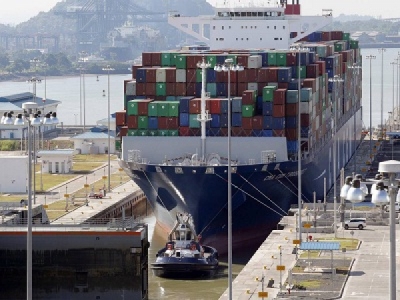
Posted on October 10, 2017
By Costas Paris, The Wall Street Journal
Panama’s $5 billion investment to expand its century-old canal is paying off as shipping lines send more U.S.-bound cargoes through the passage instead of the Suez Canal.
Ships nearly three times as large as the ones crossing before the expanded locks opened in June of 2016 are bringing tens of millions of additional dollars in tolls and a trading boom to U.S. East Coast ports, allaying some fears that investments to cater to the bigger vessels wouldn’t see enough returns.
Since the start of the year, transiting tonnage at the Panama Canal has increased by nearly 23%, canal executives say. Last week marked the 2,000th transit of a ship that wouldn’t have fit through the old locks.
“It’s an unprecedented increase and demand is driven by the expanded East Coast and U.S. Gulf ports that have been preparing for the new locks,” said Manuel Benitez, the Panama Canal Authority’s deputy administrator.
The widened waterway means importers as far inland as Tennessee could find it cheaper to bring in Asian goods to ports like New York, Savannah, Ga., and Charleston, S.C., rather than move them by rail and truck from West Coast ports, which handle about two-thirds of Asia-to-Americas trade.
The Panama Canal is also helping U.S. exporters of natural gas send bigger loads to Asian markets.
“We are very big users of the Panama Canal,” said Anatol Feygin, chief commercial officer of Cheniere Energy Inc., a major U.S. LNG exporter. “It’s a tool in our arsenal that improves the efficiency of our…deliveries from the Atlantic to the Pacific basin.”
Houston-based Cheniere began exporting liquefied natural gas in February from its Sabine Pass terminal in Louisiana. Before the opening of the new Panama locks, its tankers had to go around the tip of South America to deliver gas to South Korean, Chinese and Japanese clients. It now sends around 42% of Sabine Pass cargoes through the Panama Canal, with the remainder going to other markets.
The new locks took nine years and cost $5.4 billion, paid for with government-backed bank loans. The locks allow vessels moving up to 14,800 containers to cross, while the old locks, which still operate, can only handle ships carrying up to 5,000 containers.
Before the opening of the locks, the isthmus handled a weekly average volume of 53,000 containers, according to marine data provider PR News Service, which is closely followed by the industry. The weekly average in September was 58,000 and much of the increase was from ship diversions from the Suez in Egypt, where weekly capacity from Asia to the U.S. East Coast fell by nearly 18% in September since the locks opened to about 30,400 containers.
Total weekly container volume at East Coast ports is expected to be up 29% at the end of October since the start of the year, because of increasing traffic through Panama and the Suez, according to PR News Service.
Officials at the Suez Canal didn’t respond to requests for comment.
Savannah—the East Coast’s No. 2 container gateway after New York—expects to handle around 10% more cargo this year, double the average growth rate in previous years. Much of the gains have come from bigger ships crossing the Panama Canal, officials said. The ports of New York, Baltimore, Charleston, Virginia and Georgia also have seen a boost in container traffic.
“The transformational change happened in April this year when ocean shipping alliances realigned and introduced much bigger vessels that could now cross the isthmus,” said Griff Lynch, executive director of Georgia Ports Authority. Savannah is now unloading up to 5,000 boxes from a single vessel compared with around 1,000 in the past, as ocean carriers consolidate more of their cargo on fewer but bigger ships.
Officials are pumping $1 billion into dredging and other work around Savannah’s port. The South Carolina Ports Authority is putting $2 billion to upgrade the Charleston port, where container volume rose 10% in the fiscal year ended June from the previous year. New York spent more than $4 billion for expansion works including raising the Bayonne Bridge for the bigger ships to clear it, while the Virginia Port Authority recently disclosed plans to dredge a channel deeper than the Port of Los Angeles, the busiest in the nation.
Maersk Line, the world’s biggest container operator, is using Panama for three out of four weekly services between Asia and the U.S. East Coast, with the fourth crossing the Suez. Before the new Panama locks, Maersk, a unit of Danish conglomerate A.P. Moller Maersk A/S, operated two weekly services, both of which went through the Suez.
“With the new locks, Panama is preferable for sailings from Shanghai and further north like Korea to ports south of New York,” said Anders Boenaes, head of Maersk Line’s network. “It’s up to 12 weeks for a round voyage through Panama, one week less than through the Suez.”
The widened waterway could shift as much as 10% of Asian container imports to the East Coast from the West Coast by 2020, according to a 2015 study by the Boston Consulting Group and C.H. Robinson Worldwide Inc., a freight-forwarding company.
That doesn’t mean ports like Los Angeles and Long Beach, Calif., the nation’s two biggest gateways, will shrink anytime soon. Western ports are deep enough and bridges high enough to allow behemoths moving more than 18,000 containers to cross along with crude supertankers—too big even for the new Panama Canal.
Source: The Wall Street Journal





